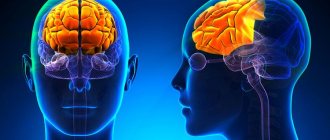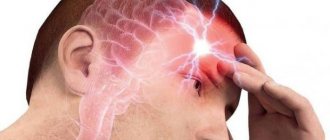How to get rid of vegetative vascular dystonia at home?
Vegetative-vascular dystonia (VSD), or neurocirculatory dystonia (NCD) is a complex polyetiological disorder that develops with dysfunction of the autonomic nervous system, which regulates the activity of internal organs and blood vessels. This disease can also be found under the names “cardioneurosis”, “vegetoneurosis”, which show the relationship between the symptoms of VSD and the state of the autonomic nervous system.
Although most doctors do not recognize the existence of such a diagnosis and do not consider it to be VSD disease, in the ICH you can find the heading F45.3, which combines all of the above diagnoses. However, for patients, vegetative-vascular dystonia becomes a real test, since the disease has a lot of variants of the course and painful symptoms, and significantly worsens the quality of life. But its duration is not affected, it has a favorable prognosis and a benign course.
What it is?
In simple words, VSD is a syndrome that appears due to nerves. In general, most problems appear precisely because of stress and anxiety, but vegetative-vascular dystonia is always the first in line.
Attacks of VSD are caused by disturbances in the functioning of the cardiovascular system, which, in turn, appear against the background of functional disorders of the nervous or endocrine system. That is, the root cause is almost always nervous shock. Which, as we know, rarely go away without leaving a trace and very often can lead specifically to neurocirculatory dystonia, which is the other name for the disease.
Causes of VSD
Among the main causes of vegetative-vascular dystonia syndrome, doctors name factors of hereditary predisposition. Against the background of unfavorable external factors, these reasons can have a significant impact on the state of the human autonomic nervous system. The leading component of the manifestations and intensification of the syndrome is the brain, namely the hypothalamus, which is responsible for controlling the human endocrine system. Psychoneurological disorders lead to excessive activity of some processes and inhibition of others, which has a complex effect on various systems of the body, including the cardiovascular system.
- Most often, vegetative-vascular dystonia in children is detected as a consequence of heredity. Increased nervousness and stress already in the first months of pregnancy can have a significant impact not only on the formation of the child’s personality, but also on the higher nervous activity of the brain. Facts show that the emotional instability of a child’s body provokes the development of VSD even in childhood.
- The teenage years are transitional not only in the process of transformation of a child into an adult, but also in a neurophysiological one. Conflict situations, emotional stress, chronic diseases, endocrine disorders, lack of movement and other factors are largely provocateurs for the development of vegetative-vascular dystonia in adolescents. Increased mental stress, having a hereditary component, leads to a certain imbalance in the body, which leads to the appearance and development of vegetative-vascular dystonia.
- In adulthood, hormonal changes in the body play a special role in triggering the mechanisms of VSD. This is why the female half of the world’s population suffers from VSD much more often than the male half. The prenatal period, pregnancy, menopause, all of this, being turning points in a woman’s life, can become the starting point for mobilizing the manifestation of symptoms of vegetative-vascular dystonia. Vegetative-vascular dystonia is especially unfavorable during pregnancy, when even minor deviations in a woman’s health necessarily affect the condition of the fetus.
The same is true for the presence of excess weight, which can provoke manifestations of dystonia. An increase in body weight leads to the development of hypertension, which in turn is an additional burden on the cardiovascular system. The development of vegetative-vascular dystonia in this case affects people of completely different ages.
Complications
Despite the fact that dystonia of the vegetative-vascular system is not considered as an isolated disease, many symptoms can lead to serious complications:
- Vegetative crisis. The complication manifests itself as regular panic attacks, tachycardia, and pale skin. During a vagoinsular crisis, breathing is difficult, flatulence occurs, blood pressure and pulse decrease, and diarrhea is possible. The likelihood of loss of consciousness increases.
- Cardiovascular diseases. Against the background of crises, hypertension or hypotension, tachycardia, and arrhythmia develop. Disruption of the heart and vascular tone can lead the patient to myocardial infarction, stroke and other dangerous diseases.
- Neurological and mental diseases. If you do not try to stop the attacks, the condition will worsen. A disorder in the functioning of the vegetative-vascular system leads to the appearance of obsessions, a constant experience of fear, and tremors of the limbs.
- Digestive disorders. If crises are manifested by disruption of the gastrointestinal tract, the situation will subsequently worsen. The patient may develop gastritis, peptic ulcers, gastroenteritis and other diseases in which food is poorly digested, constipation occurs, and appetite is lost.
Vegetative-vascular dystonia (dysfunction syndrome of the autonomic nervous system) in itself is not a life-threatening disease. But it leads to complications that worsen the quality of life and give rise to other pathologies, the consequences of which can be threatening. The sooner you start treating the disease, the faster you will be able to get rid of the symptoms.
In our clinic, patients will receive qualified medical care. Here, patients will be able to undergo a full examination and consult with specialists. Our doctors approach drawing up a treatment plan individually, taking into account the characteristics of each patient’s body.
Types of disease
As a result of vegetative vascular dystonia, the brain and heart, kidneys, and limbs suffer. Therefore, autonomic dystonia syndrome is like a chameleon: in different people it manifests itself with such different symptoms that it is difficult to suspect their common cause. There are three types of pathology: hypertensive, hypotonic and mixed.
- If, regardless of the “internal need,” the sympathetic nervous system predominates during the day, they speak of a hypertensive type of vegetative-vascular dystonia. The person complains of attacks of palpitations and/or panic, anxiety, gets tired quickly, but has difficulty falling asleep in the evening. Blood pressure is elevated or unstable.
- When the parasympathetic nervous system predominates throughout the day, a person feels weakness, drowsiness, fatigue, and occasionally dizziness and fainting; we are talking about the hypotonic type of VSD. The pressure is reduced.
- When the sympathetic and parasympathetic systems “fight” for leadership, alternately winning and losing, hyper- and hypotonic symptoms replace each other, they speak of a mixed type.
Upon examination, it turns out that the organs and systems are in order, there are no pathologies in them, and such VSD is called primary. If the symptom complex of vegetative-vascular dystonia occurs against the background of another disease, it is considered secondary.
About vegetative-vascular dystonia
Vegetovascular dystonia (in other words, autonomic dysfunction) is a disorder of the autonomic nervous system.
The autonomic nervous system is part of the nervous system that regulates many processes in the internal organs. It is sometimes called the autonomic nervous system because... regulation occurs autonomously, i.e. without the participation of human consciousness. The autonomic nervous system conventionally has two divisions: sympathetic and parasympathetic, which are responsible for oppositely directed actions: for example, the parasympathetic division stimulates digestion, and the sympathetic one slows it down. Normally, the parasympathetic and sympathetic systems are in balance without predominance of one over the other.
Vegetovascular dystonia is an imbalance in the autonomic nervous system, the consequence of which is disruption of the functioning of internal organs. Vegetative-vascular dystonia affects up to 70% of the adult population and 15-25% of children.
First signs
Disorders of the autonomic nervous system can cause very diverse manifestations; about 150 of them are known. For VSD, the most characteristic symptoms are those associated with the vascular reaction and the central nervous system:
- headache;
- noise in ears;
- dizziness;
- tendency to faint;
- increased heart rate;
- weakness, drowsiness;
- increased sweating;
- unclear increase in body temperature;
- muscle pain;
- trembling in the body and hands.
Individuals with vegetative-vascular dystonia are characterized by mental characteristics:
- sudden changes in emotions;
- tendency to panic;
- obsessive thoughts;
- increased anxiety;
- suspiciousness in character.
Symptoms of vegetative-vascular dystonia (VSD), complaints with VSD, how does it manifest?
Which VSD clinic? The main clinical feature of patients with vegetative-vascular dystonia (VSD) is the presence of numerous complaints in patients, a variety of different symptoms and syndromes , which is due to the characteristics of pathogenesis and the involvement of hypothalamic structures in the process. The most common symptoms of VSD : cardialgia, asthenia, neurotic disorders, headache, sleep disturbances, dizziness, respiratory disorders, palpitations, cold hands and feet, vegetative-vascular paroxysms, hand tremors, internal tremors, cardiophobia, myalgia, joint pain, swelling tissues, heart failure, feeling of heat in the face, low-grade fever, fainting, nausea, lack of air, anxiety, lump in the throat , panic attacks, sweating, weakness, chills. The most consistent signs of the diagnosis of VSD are cardialgia (pain or painful sensations in the heart); heartbeat; vascular dystonia; autonomic dysfunctions; respiratory disorders; systemic neurotic disorders. Dysuric phenomena are possible, which contribute to the occurrence of urolithiasis.
Clinical syndromes of VSD
Autonomic dysfunction syndrome combines sympathetic, parasympathetic and mixed symptom complexes of a generalized, systemic or local nature, manifesting permanently or in the form of paroxysms (vegetative-vascular crises), with non-infectious low-grade fever, and a tendency to temperature asymmetry.
- Vagotonia is characterized by bradycardia, difficulty breathing, redness of the facial skin, sweating, salivation, decreased blood pressure, and gastrointestinal dyskinesia. Vagoinsular crisis is manifested by a feeling of heat in the head and face, suffocation, heaviness in the head, nausea, weakness, sweating, dizziness, the urge to defecate, increased intestinal motility, miosis is noted, a decrease in pulse to 45-50 beats per minute, a decrease in blood pressure. up to 80/50 mm Hg. Art.
- Sympathicotonia is characterized by tachycardia, pallor of the skin, increased blood pressure, weakened intestinal motility, mydriasis, chills, a feeling of fear and anxiety. During a sympathoadrenal crisis, a headache appears or intensifies, numbness and coldness of the extremities occurs, the face becomes pale, blood pressure rises to 150/90-180/110 mmHg, the pulse quickens to 110-140 beats/min, pain in the area is noted heart, excitement, motor restlessness appear, sometimes body temperature rises to 38-39 °C.
- Syndrome of mental disorders - behavioral and motivational disorders - emotional lability, tearfulness, sleep disturbance, feeling of fear, cardiophobia. Patients with VSD have a higher level of anxiety, they are prone to self-blame, and experience fear in making decisions. Personal values prevail: great concern for health (hypochondria), activity decreases during illness. When diagnosing, it is important to differentiate between somatoform autonomic dysfunction, in which there are no mental disorders, and hypochondriacal disorder, also considered a somatogenic neurosis-like condition, as well as panic disorder and phobias, other nervous and mental diseases.
- Mixed crises are characterized by a combination of symptoms typical of crises, or their alternate manifestation. There may also be: red dermographism, zones of hyperalgesia in the precordial region, “spotted” hyperemia of the upper half of the chest, hyperhidrosis and acrocyanosis of the hands, tremor of the hands, non-infectious low-grade fever, a tendency to vegetative-vascular crises and temperature asymmetries.
- Hyperventilation (respiratory) syndrome is a subjective feeling of lack of air, chest compression, difficulty in breathing, and the need for deep breaths. In a number of patients it occurs in the form of a crisis, the clinical picture of which is close to suffocation. The most common reasons that provoke the development of respiratory syndrome are physical exertion, mental stress, staying in a stuffy room, sudden changes in cold and heat, and poor transport tolerance. Along with the mental factors of shortness of breath, a decrease in the compensatory and adaptive capabilities of the respiratory function to hypoxic loads is of great importance.
- Syndrome of adaptation disorders, asthenic syndrome - fatigue, weakness, intolerance to physical and mental stress, weather dependence. Evidence has been obtained that asthenic syndrome is based on disturbances in transcapillary metabolism, decreased tissue oxygen consumption and impaired hemoglobin dissociation.
- Cardiovascular syndrome - cardialgia in the left half of the chest that occurs during emotional rather than physical stress, is accompanied by hypochondriacal disorders and is not relieved by coronal drugs. Blood pressure fluctuations, pulse lability, tachycardia, functional murmurs. ECG and bicycle ergometry most often reveal sinus and extrasystolic arrhythmias; there are no signs of myocardial ischemia.
- Neurogastric syndrome - neurogastric aerophagia, esophageal spasm, duodenostasis and other disorders of the motor-evacuation and secretory functions of the stomach and intestines. Patients complain of heartburn, flatulence, constipation.
- Syndrome of metabolic tissue and peripheral vascular disorders - tissue edema, myalgia, angiotrophoneurosis, Raynaud's syndrome. Their development is based on changes in vascular tone and vascular permeability, disturbances in transcapillary exchange and microcirculation.
- Cerebrovascular syndrome - headaches, dizziness, noise in the head and ears, tendency to faint. Their development is based on cerebral angiodystonia, the pathogenetic basis of which is dysregulation of cerebral vascular tone of a hypertonic, hypotonic or mixed nature. In some patients with persistent cephalgic syndrome, there is a violation of the tone of not only arterial, but also venous vessels, the so-called functional venous hypertension.
Case from practice
Approximately 2-3 times a week similar episodes occur at my appointment, I would like to give one of them as an example.
A 31-year-old woman came for consultation. Complains of attacks of sudden palpitations, shortness of breath, increased blood pressure to 135/80, periodic tinnitus, dizziness, sleep disturbance, anxiety. She noted a pre-fainting state twice. The work involves constant communication by phone (operator of a government agency hotline), and frequent conflicts arise with management. Attacks occur regularly throughout the year due to emotional distress. Comprehensively examined. During an examination by a fellow therapist, he recorded an increase in blood pressure (130/80 mm Hg) and made a preliminary diagnosis of “Hypertension, stage 1.” According to instrumental examinations, there is a slight spasm of the vertebral artery on the right, the venous outflow is impaired. According to the results of ultrasound of the retroperitoneal organs, no pathologies were identified. She was examined by a gynecologist and pregnancy was ruled out.
During a neurological examination: the patient is asthenized, fixed on her own sensations. There is no pathology of the cranial nerves. Reflexes are symmetrical, lively, no pathological. Sensory and motor areas are not impaired. She is stable in the Romberg position and performs coordination tests well. Extremities feel cold to the touch. Increased sweating.
Diagnosis: “Somatoform autonomic dysfunction, hypertensive type.” Taking into account that the symptoms and treatment of vegetative-vascular dystonia in women are necessarily emotionally charged, I recommended: normalizing the daily routine, regular exercise, daily warm baths with aromatic lavender oils, and a course of massage. Among the medications, the drug “Afobazol” was prescribed, 1 tablet 2 times a day for a month, followed by a second consultation at the end of the course or in the event of an exacerbation of the condition.
The patient came for follow-up a month and a half later. The condition improved noticeably; after emotional experiences, signs of VSD stopped appearing.
This example shows well how important it is to find the cause of discomfort in time and eliminate it correctly. Symptoms and treatment of vegetative-vascular dystonia in women have their own specifics due to the bright emotional coloring. Give the young lady a chance to relax and get some rest - success will not be long in coming. Men should remember this.
Symptoms of VSD in men
Men are less likely to present with complaints characteristic of vegetative-vascular dystonia. I attribute this to the fact that they are more resilient to stress. However, with overwork, prolonged intellectual overstrain, they also experience vegetative breakdowns. More often, the symptom complex debuts in males after 40 years of age, which is associated with incipient changes in hormonal levels, drinking alcohol, smoking, and spending a lot of time in front of the computer.
Signs of VSD in men are no different from those in women; the severity of the manifestations depends only on the degree of lability of the patient’s nervous system and his susceptibility to stressful situations. During a neurological examination, I often note the following symptoms:
- erectile disfunction,
- visual impairment,
- pain in the heart area (cardialgia).
Panic attack
This is another syndrome that will be a characteristic symptom of vegetative-vascular dystonia. A person experiences severe fright, a feeling of approaching anxiety, and a wave of fear covers him.
At the same time, the body sends signals about danger, but it does not provide options for solving the problem. Therefore, the patient experiences a strong fear of death, it seems to him that his heart stops, his breathing takes away. It is noteworthy that literally after 10-15 minutes the panic attack against the background of VSD passes, and the person’s condition returns to normal.
Current of VSD
In most cases, without provoking factors, the disease is latent (asymptomatic).
However, under the influence of unfavorable conditions and overloads, crises often occur. Such crises are sometimes sudden in nature and are accompanied by symptoms characteristic of many diseases: pallor, sudden sweating, decreased blood pressure, abdominal pain, nausea and vomiting, and decreased body temperature.
A crisis surge in disease activity is more severe in older people, especially those who suffer from concomitant diseases. In many cases, a crisis is the result of long-accumulated components, and therefore it is not uncommon for a large number of symptoms to manifest simultaneously.
Symptoms of VSD in the acute stage
The cardiovascular symptom complex in VSD is manifested by the following symptoms:
- changes in heart rate;
- lability of blood pressure;
- pathological vasomotor reactions (redness, cyanosis, pallor of the skin, hot flashes, chilliness of the feet and hands).
In the acute stage, burning, stabbing, pressing, throbbing pain or discomfort in the heart area is observed.
The respiratory symptom complex is manifested by increased ventilation (rapid deep breathing), psychogenic shortness of breath (sniffling, yawning, coughing, periodic deep breaths). Hyperventilation always accompanies anxiety. Shortness of breath is accompanied by dissatisfaction with inhalation, a feeling of lack of air, intermittent breathing, and a feeling of stopping breathing. In the acute stage, muscle spasms and a crawling sensation around the mouth and in the distal limbs occur. Neurologists define Chvostek's symptom - contraction of the muscle that raises the corner of the mouth when tapped in the projection of the facial nerve. Hyperventilation may cause the following symptoms:
- headache;
- fainting state;
- pain in the heart area;
- heart rhythm disturbance;
- abdominal pain, combined with increased peristalsis, nausea, and belching of air.
The gastrointestinal symptom complex is characterized by a disorder of the functions of the digestive organs. May exhibit the following symptoms:
- disturbances of appetite, motility of the esophagus, stomach or intestines;
- psychogenic dysphagia (difficulty, discomfort during the act of swallowing or the inability to take a sip);
- vomiting;
- feeling of heaviness in the epigastrium;
- transient flatulence (bloating);
- diarrhea;
- pain in the abdominal cavity.
The thermoregulatory symptom complex is manifested by an increase or decrease in temperature, chill syndrome. The vasomotor symptom complex consists of several symptoms:
- pallor, cyanosis of the skin;
- chilliness of hands, feet;
- sensations of hot or cold flashes;
- changes in dermographism (weak mechanical irritation of the skin when carried out with a blunt object causes a trace in the form of inflamed swelling);
- increased sweating of the palms and feet.
The genitourinary complex is characterized by cystalgia (frequent, painful, imperative urination in the absence of pathology of the urinary system or changes in urine) and sexual dysfunction (impaired erection or ejaculation in men, vaginismus or anorgasmia in women with preserved or reduced libido, painful menstruation). Hormonal fluctuations, including endocrine changes in the body after childbirth, and postpartum stress provoke an exacerbation of VSD symptoms.
The neurotic symptom complex is manifested by the following symptoms:
- fatigue;
- asthenia;
- low threshold of pain sensitivity;
- sleep disorders;
- irritability;
- senestopathies (pain in the heart, a feeling of dissatisfaction with inhalation, a burning sensation in different parts of the body).
VSD occurs with a wave-like increase and decrease in the manifestations of symptom complexes. This is due to changes in etiological factors and living conditions of the patient. An exacerbation of VSD may occur in the fall. Symptoms of the disease are most pronounced during a “vegetative storm” or crisis.
Diagnostics
As already mentioned, VSD is a diagnosis of exclusion. Therefore, to diagnose it, all additional methods are needed that will exclude organic pathology. A general examination of the patient is needed, consultation with a neurologist, cardiologist, gastroenterologist and endocrinologist.
A complete cardiac examination is carried out: laboratory tests, cholesterol, ECG, ultrasound of the heart, exercise tests, Holter ECT and blood pressure. Also prescribed are x-rays of the chest organs, ultrasound of the abdominal organs, kidneys and thyroid gland, fibrogastroscopy, colonoscopy for gastrointestinal complaints. The level of thyroid hormones is determined, since its pathology is accompanied by similar symptoms.
If no pathology is found during all additional examinations, then the patient is diagnosed with vegetative-vascular dystonia in accordance with:
- leading clinical syndrome (cardiac, hypotonic, hypertensive, respiratory, asthenic, neurotic, mixed variant of the course);
- degree of severity – mild (3-6 complaints and symptoms), moderate (8-16 signs), severe (more than 17 signs and frequent crises);
- phase of the disease (exacerbation or remission).
Treatment of vegetative-vascular dystonia
In the case of the described disorder, the treatment regimen for vegetative-vascular dystonia in women and men must be comprehensive, long-term, and take into account the characteristics of the dysfunctions, the etiological factor and the individual specifics of the person. If this disorder is advanced, therapeutic measures will be lengthy.
So, how to get rid of vegetative-vascular dystonia in adults? As a rule, treatment measures involve the use of non-drug regimens, which can be supplemented with sedatives.
Non-drug therapeutic measures for the treatment of vegetative-vascular dystonia in women and men include:
- Optimization of periods of work and rest. In order to get rid of the symptoms of VSD, you should evenly alternate between mental and physical labor, and minimize the time spent in front of a computer monitor and TV. If this is not possible, take a break every 60-90 minutes, do gymnastics for the eyes, and warm up for the back.
- Maintaining a stable daily routine with mandatory proper rest. The normal duration of night sleep varies from person to person. But for most, this figure should not be less than 8-9 hours. Sleeping conditions are also important. The bedroom should not be stuffy; regular ventilation and wet cleaning are necessary. The bed should be comfortable and suitable for the person’s height and build. It is better to give preference to an orthopedic mattress and pillow.
- A diet that includes foods rich in potassium and magnesium. It is these minerals that are involved in the transmission of impulses in nerve endings, improve the activity of the heart and blood vessels, and restore balance in the functioning of the nervous system. Therefore, for VSD, it is recommended to consume buckwheat and oatmeal, legumes, dried fruits, nuts, herbs, potatoes, carrots and eggplants.
- Adequate physical activity. The optimal activities are those that take place in the fresh air or in the water, but do not put a significant strain on the muscular and cardiovascular systems. Swimming, water aerobics, dancing, skiing and cycling are most suitable for a patient suffering from vegetative-vascular dystonia. With such loads, gentle training of the heart occurs and the psycho-emotional state is normalized. At the same time, you should avoid sports that require sudden movements, high jumps, or staying in static tension for a long time. This creates additional stress on the vessels and can lead to worsening of the disease.
- Acupuncture and massage promote relaxation, eliminate anxiety, normalize blood pressure, and restore sleep. For the hypertensive type, massage movements are indicated at a slow pace with increased impact on the collar area. With a hypotonic variant of VSD, on the contrary, the massage should be fast and intense.
- The use of herbal preparations. For VSD with increased blood pressure, herbs with sedative and hypotensive effects (tincture of valerian, peony, motherwort) are suitable. The hypotonic variant of the disease requires taking drugs with a stimulating and activating effect (eleutherococcus, aralia, ginseng).
- Physiotherapy methods have a positive effect in vegetative-vascular dystonia due to the normalization of the interaction of various parts of the nervous system and vascular tone. Such procedures improve blood circulation in organs and tissues and activate metabolic processes. The list of techniques used is quite large: electrophoresis with medicinal solutions on the cervical spine, ozokerite or paraffin applications on the collar area, laser irradiation in combination with magnetotherapy. Water procedures have an excellent effect. For all types of VSD, contrast baths, circular and fan showers, underwater massage, and swimming are recommended.
- For hypotonic type VSD, it is necessary to consume foods that increase vascular tone: green tea, natural coffee, milk. In case of hypertensive variant of the disease, foods that provoke a rise in blood pressure should be excluded from the diet: strong tea and coffee, pickles and spicy dishes.
When diagnosing vegetative-vascular dystonia, drugs are prescribed exclusively by the attending physician. The therapeutic effect is focused on restoring balance in the functioning of the ganglion system.
How to treat vascular dystonia
VSD may not manifest itself for a long time, but under certain conditions it occurs again, bringing discomfort to my patients. During the appointment, I try to explain in detail how you can strengthen the vascular response to stress.
Depending on the symptoms of VSD, I recommend:
- physical education at home or sports under the supervision of professional trainers are the most important helpers in the fight against dystonia;
- normalization of sleep and wakefulness (sleep at least 8 hours);
- diet: exclude provoking foods (coffee, alcohol, fried, fatty foods), add vegetables and fruits rich in vitamins and potassium salts to the diet;
- massage courses;
- herbal medicine - the aromas of mint, apricot, almond, lavender have soothing properties;
- psychotherapy (the psychosomatic model of dystonia was neither refuted nor confirmed);
- Spa treatment.
If the condition does not improve, they resort to drug treatment. Pharmacies offer a large selection of drugs that patients like to prescribe for themselves, without doctor’s recommendations, which always upsets me. An individually selected drug, taking into account the nature of dystonia, will definitely have an effect.
What pills do I recommend to my patients to combat VSD:
- Antidepressants are the drugs of choice No. 1; they work great for VSD.
- Nootropic drugs – improve energy metabolism in brain cells. Many patients buy drugs whose effectiveness has not been proven, for example, Eltacin (we often have disputes with them about the advisability of its use in vegetative crises). This dietary supplement contains the amino acids glycine, glutamic acid and cystine. In some cases, I consider it as a preventative measure.
- Anxiolytics, or tranquilizers, have a relaxing effect, relieve feelings of fear, anxiety, anxiety, but have side effects - drowsiness, slow reactions, memory loss, etc. For patients with VSD without crises, I recommend taking Afobazol. "Phenozepam" is a stronger drug, so it is preferable to take it under the supervision of a physician.
- I prescribe angioprotectors to normalize cerebral circulation.
- Antioxidants improve stress resistance. I recommend Mexidol if the metabolic processes of the brain and blood circulation are disrupted. During my work, patients did not complain of side effects.
As a doctor, I am skeptical about homeopathic medicines - due to the lack of a sufficient number of studies that would show their effectiveness in VSD.
The main thing with VSD is prevention. You can forget about your ailments for a long time and live a full life. If you strictly follow all the recommendations for combating dystonia, it will recede for many months and even years. If you still have questions regarding this syndrome, we recommend watching the video located below the link. Briefly, accessiblely and professionally about symptoms, diagnosis and treatment from the experts of our portal. Enjoy watching!
Doctor's advice: how to live with VSD and what you should limit yourself to
- Try to avoid stressful situations.
- If possible, normalize daytime activity and nighttime sleep.
- Exercise at least 2 times a week
- If you feel an attack approaching, try to relax, if possible, lie down. If the sensations intensify, consult your doctor; adjustments in treatment or recommendations may be necessary.
- If a consultation with a psychotherapist or psychiatrist is recommended, do not refuse, visit a doctor; in many cases, this particular specialist will help you understand your conditions and prescribe effective treatment.
Drugs for VSD
Drugs for the treatment of vegetative-vascular dystonia in women and men are determined by the predominant symptoms in a particular patient. The main group of drugs for VSD consists of drugs with a sedative effect:
- Herbal remedies – valerian, motherwort, novo-passit, etc.;
- Antidepressants – cipralex, paroxetine, amitriptyline;
- Tranquilizers - seduxen, elenium, tazepam, grandaxin.
In some cases, nootropic drugs (piracetam, omnaron), vascular drugs (cinnarizine, Actovegin, Cavinton), psychotropics - Grandaxin, Mezapam, Sonapax - are prescribed. With the hypotonic type of VSD, taking adaptogens and tonic herbal remedies - eleutherococcus, ginseng, pantocrine - helps.
As a rule, treatment begins with “milder” herbal remedies; if there is no effect, mild tranquilizers and antidepressants are added. With severe anxiety, panic attacks, and neurosis-like disorders, medication correction is absolutely indispensable.
Symptomatic therapy is aimed at eliminating symptoms from other organs, primarily the cardiovascular system.
For tachycardia and increased blood pressure, anaprilin and other drugs from the group of beta-blockers (atenolol, egilok), and ACE inhibitors are prescribed. Cardialgia is usually relieved by taking sedatives - Seduxen, Corvalol, Valocordin.
Bradycardia less than 50 heart beats per minute requires the use of atropine and belladonna preparations. Cool, tonic baths and showers and physical exercise are helpful.
Symptoms
Signs of autonomic dysfunction can have varying degrees of severity - from slight discomfort to a powerful attack. The coverage area can extend only to one organ, or it can disrupt the functioning of several systems at once. Depending on the mechanisms of occurrence and development, symptoms are divided into several main groups:
- cephalgic syndrome
(regular prolonged headaches of varying intensity); - asthenic syndrome
(nausea, dizziness, fainting, weakness, lack of appetite, intolerance to high or low temperatures); - cardiac dysfunction syndrome
(increased heart rate, irregular heart rhythm, surges in blood pressure); - thermoregulation disorders
(chills, low or low-grade fever, sweating); - neurotic disorders
(increased excitability, irritability, depressive states, insomnia); - respiratory syndrome
(shortness of breath, rapid or shallow breathing).
In addition, autonomic dysfunction can indirectly affect the functioning of the digestive tract (intestinal spasms, diarrhea, etc.) and the genitourinary system (frequent urination, anorgasmia).
Folk remedies
First of all, treatment of VSD with folk remedies involves providing vascular support.
- Calming charges. To restore the harmonious state of the nervous system, it is useful to drink herbal infusions, which you can purchase at the pharmacy or prepare yourself. Here is one of them: mix valerian root, cumin, motherwort, dill and calendula in equal proportions. Pour 1 teaspoon of the mixture into 150 ml of boiling water, leave for 2 hours and strain. Take the medicine 5 times a day, 15 ml for a month. It is not recommended to skip, since regularity of administration directly affects the effectiveness of treatment.
- Another balm is prepared not only to strengthen blood vessels, it helps with strokes and heart attacks, vascular atherosclerosis, noise in the head, ears, inflammatory processes - given the composition, it turns out to be a very powerful remedy. To make it, three tinctures are prepared: 40 grams of red clover flowers are poured with 40% alcohol in an amount of 500 ml and infused in the dark for 14 days, then filtered. The second infusion is prepared from the root of the Caucasian dioscorea in an amount of 50 grams, pre-crushed. The ingredient is poured with 40% alcohol in a volume of 500 ml and infused like clover. The third tincture is prepared from soft propolis, which is crushed and filled with 70% alcohol in a darkened glass container in a ratio of 100 grams per 1000 ml. The container is tightly closed, infused in the dark for 10 days at room temperature, and filtered. Then the tinctures are thoroughly mixed in a 1:1:1 ratio. The balm is taken in a small spoon three times a day after meals, first diluted with water in a volume of 50 ml. The duration of such therapy is two months. Then you should take a break for 14 days and repeat the course.
- You need to take a glass of dry dill seeds, add two large spoons of crushed valerian root to them, place the mixture in a thermos and add a liter of water brought to a boil. The composition is infused for 24 hours, after which it is filtered and 500 ml of natural honey is added to the liquid. Mix everything thoroughly and place in the refrigerator. The medicine is taken three times a day before meals. At least 30 minutes should pass before eating. A single amount of the mixture is one large spoon. The course of treatment lasts until the end of the prepared drug.
This is not worth doing
What should not be done by patients with vegetative-vascular dystonia?
- Get involved in diets and fasting.
- It's hard to look at what's happening in life negatively.
- Create additional stress for the body - contrast showers, modern breathing practices.
- Practice meditation.
- Exhaust yourself with heavy physical activity.
- Try to find a new manifestation of the disease in yourself.
- Drinking alcohol.
Also listen to amateurs in this matter (neighbors, girlfriends, acquaintances, relatives who do not have a medical education), especially when it comes to prescribing medications!
Treatment
When treating VSD, an integrated approach is used, combining physical, psychological and medicinal effects. The main treatment strategy is aimed at improving the cardiovascular and nervous systems of the body. If normalization of the regimen (healthy diet, adequate sleep, dosed physical activity) does not bring satisfactory results, the patient may be prescribed:
- medications (drugs to normalize blood pressure, sedatives and nootropics, as well as antidepressants and tranquilizers);
- physiotherapy (massage, physical therapy, acupuncture, balneotherapy);
- balanced diet, taking vitamin and mineral complexes;
- psychotherapeutic methods of influence;
- low- and medium-intensity sports activities (swimming, walking).
Timely diagnosis, adequate therapy and systematic prevention in the vast majority of cases completely eliminate the manifestations of the disease.
Let's sum it up
Many doctors believe that such a diagnosis does not exist. The alarming thing is that no one has yet decided on the nomenclature of the disease, everyone calls it differently, no one can say exactly how it manifests itself.
Any of the symptoms related to the symptoms of vegetative-vascular dystonia can be found in any person at any period of his life. Not all people in the world can suffer from any disease.
- The symptoms of vegetative-vascular dystonia are described very vaguely and in different ways in different sources. Most patients who have been diagnosed with this for years find it difficult to explain that they do not have such a disease, and indeed that such a disease does not exist. Otherwise, a completely logical question arises: what was he treated for all these months or years?
- For many doctors, this diagnosis is a “lifeboat” or a “garbage can”, depending on which way you look at it. If a patient has a number of symptoms, but the examination does not reveal any significant organic pathology, it is impossible to tell him that everything is fine.
- He came with complaints, something was bothering him, something brought him to the doctor’s office. He simply will not understand the doctor and will decide that he is not competent enough and will go to another doctor, in the hope that he will understand the problem. Therefore, the doctor uses a proven method and writes the diagnosis “vegetative-vascular dystonia” on the card.
Then he prescribes harmless valerian, motherwort, and walks in the evenings under the moon, accompanied by thoughts about something positive. What do we have? And the wolves are fed, and the sheep are safe. The patient is glad that the cause of his problems has been found; fortunately, the reason is trivial, because most of his friends and relatives have vegetative-vascular dystonia.







